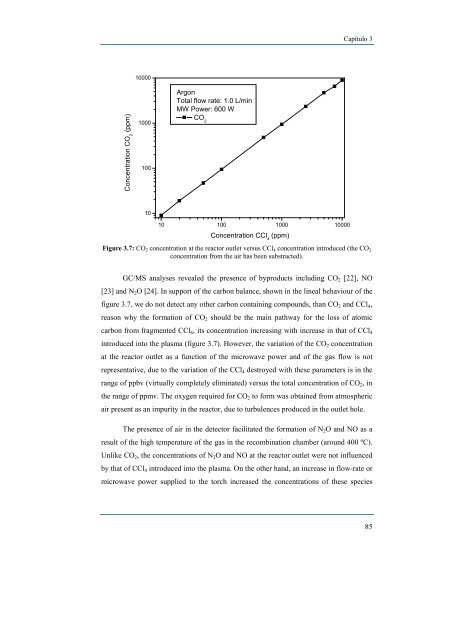estudio y caracterización de un plasma de microondas a presión ...
estudio y caracterización de un plasma de microondas a presión ...
estudio y caracterización de un plasma de microondas a presión ...
You also want an ePaper? Increase the reach of your titles
YUMPU automatically turns print PDFs into web optimized ePapers that Google loves.
Concentration CO 2 (ppm)<br />
10000<br />
1000<br />
100<br />
10<br />
Argon<br />
Total flow rate: 1.0 L/min<br />
MW Power: 600 W<br />
CO 2<br />
10 100 1000 10000<br />
Concentration CCl 4 (ppm)<br />
Capítulo 3<br />
Figure 3.7: CO 2 concentration at the reactor outlet versus CCl 4 concentration introduced (the CO 2<br />
concentration from the air has been substracted).<br />
GC/MS analyses revealed the presence of byproducts including CO2 [22], NO<br />
[23] and N2O [24]. In support of the carbon balance, shown in the lineal behaviour of the<br />
figure 3.7, we do not <strong>de</strong>tect any other carbon containing compo<strong>un</strong>ds, than CO2 and CCl4,<br />
reason why the formation of CO2 should be the main pathway for the loss of atomic<br />
carbon from fragmented CCl4, its concentration increasing with increase in that of CCl4<br />
introduced into the <strong>plasma</strong> (figure 3.7). However, the variation of the CO2 concentration<br />
at the reactor outlet as a f<strong>un</strong>ction of the microwave power and of the gas flow is not<br />
representative, due to the variation of the CCl4 <strong>de</strong>stroyed with these parameters is in the<br />
range of ppbv (virtually completely eliminated) versus the total concentration of CO2, in<br />
the range of ppmv. The oxygen required for CO2 to form was obtained from atmospheric<br />
air present as an impurity in the reactor, due to turbulences produced in the outlet hole.<br />
The presence of air in the <strong>de</strong>tector facilitated the formation of N2O and NO as a<br />
result of the high temperature of the gas in the recombination chamber (aro<strong>un</strong>d 400 ºC).<br />
Unlike CO2, the concentrations of N2O and NO at the reactor outlet were not influenced<br />
by that of CCl4 introduced into the <strong>plasma</strong>. On the other hand, an increase in flow-rate or<br />
microwave power supplied to the torch increased the concentrations of these species<br />
85

















